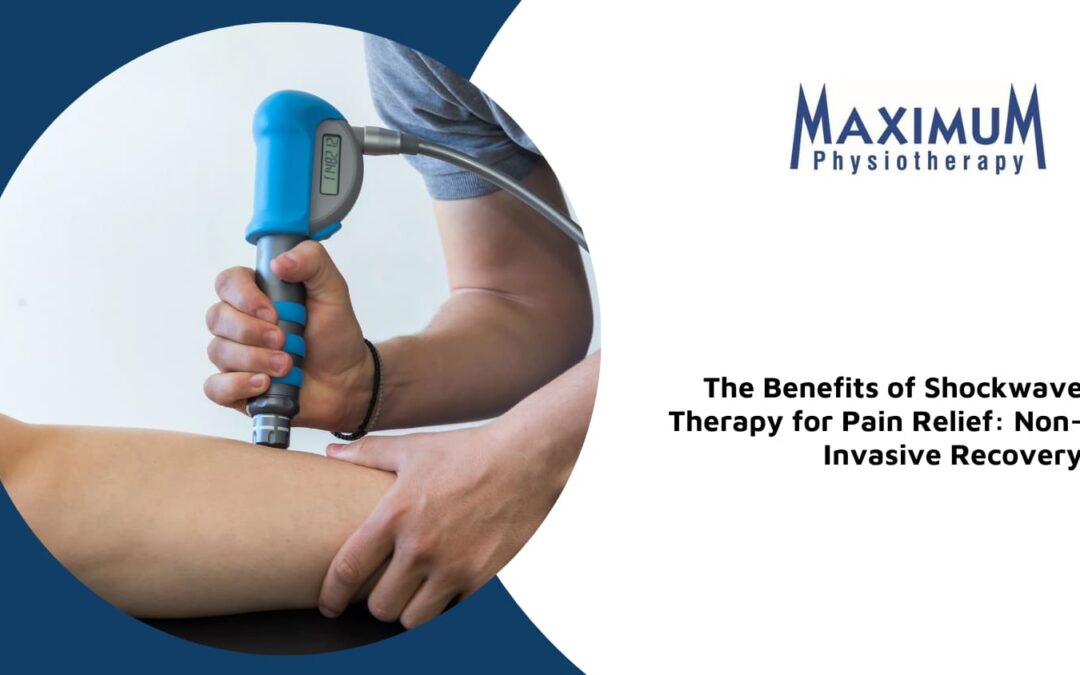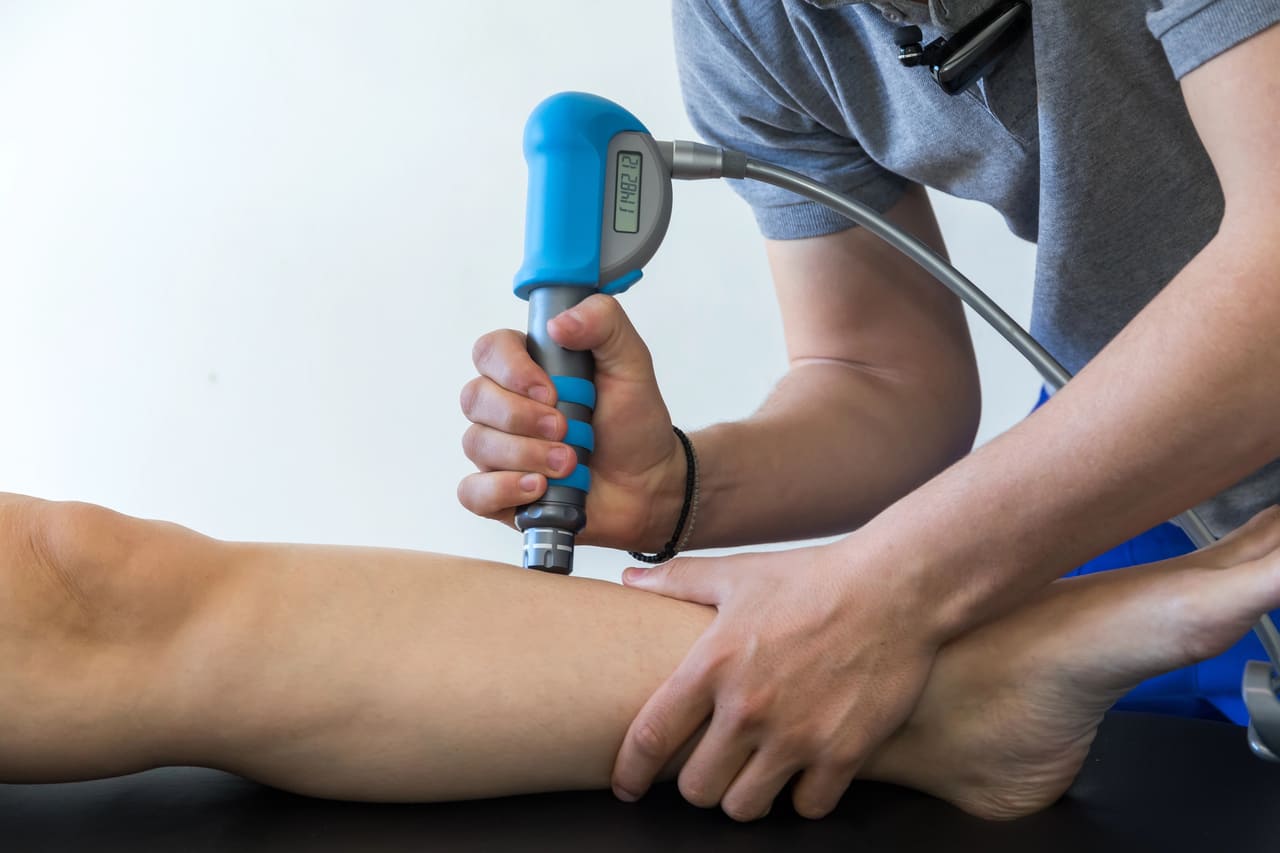
The Benefits of Shockwave Therapy for Pain Relief: Non-Invasive Recovery

In the realm of physiotherapy, shockwave therapy is gaining traction for its innovative approach to pain relief. This non-invasive treatment uses acoustic waves to stimulate the body’s natural repair processes, offering a promising option for those seeking alternatives to traditional pain management. In this blog, we will explore how shockwave therapy works for pain relief, the types of pain it can address, its safety and efficacy, and more. By understanding these aspects, individuals can make informed decisions about incorporating shockwave therapy into their recovery plans.
What Is Shockwave Therapy And How Does It Relieve Pain?
Shockwave therapy is a non-invasive treatment that uses high-energy acoustic waves to promote pain relief and tissue recovery. These waves interact with the tissues in the body, encouraging the natural repair processes. Shockwave therapy is particularly effective for musculoskeletal disorders and conditions involving tendons and ligaments.
- Acoustic Waves: These are the primary agents in shockwave therapy. They penetrate the skin to reach the affected area, stimulating cellular activity and promoting blood circulation.
- Pain Reduction Mechanism: The therapy helps reduce pain by desensitizing nerve endings and interrupting pain signals, providing relief from chronic pain conditions.
- Tissue Recovery: Shockwave therapy enhances collagen production, which is crucial for repairing damaged tissues, particularly in tendons and ligaments.
- Inflammation Reduction: By promoting better blood flow, the therapy aids in reducing inflammation, which is often a source of pain in chronic conditions.
- Calcium Deposit Breakdown: In conditions like calcific tendonitis, shockwave therapy can help break down calcium deposits, facilitating better movement and reducing pain.
- Trigger Point Treatment: It is also effective in treating trigger points, which are tight areas within muscle tissue that cause pain in other parts of the body.
- Versatility: Shockwave therapy can be used for various conditions, ranging from plantar fasciitis to tennis elbow and beyond.
In summary, shockwave therapy offers a comprehensive approach to pain relief, addressing both symptoms and underlying causes. Its versatility makes it a valuable tool for managing various conditions.
What Types Of Pain Can Be Treated With Shockwave Therapy?
Shockwave therapy can treat a wide array of pain conditions, particularly those affecting the musculoskeletal system. It is effective for chronic pain, sports injuries, and specific conditions like plantar fasciitis and tendonitis.
|
Plantar Fasciitis |
A common cause of heel pain, shockwave therapy can help reduce inflammation and promote tissue recovery in the plantar fascia. |
|
Tennis Elbow |
Known medically as lateral epicondylitis, this condition benefits from shockwave therapy by reducing pain and improving arm function. |
|
Achilles Tendonitis |
This therapy aids in recovering from inflammation and microtears in the Achilles tendon, promoting better mobility and reducing discomfort. |
|
Calcific Tendonitis |
Shockwave therapy can help break down the calcium deposits in tendons, relieving pain and restoring movement. |
|
Often seen in athletes, this condition involves pain in the knee area, which can be alleviated by promoting tissue recovery through shockwave therapy. |
|
|
Myofascial Pain Syndrome |
Trigger points causing referred pain can be effectively treated with shockwave therapy, offering relief and improving function. |
|
Hip Bursitis |
This therapy can reduce inflammation in the bursa, easing hip pain and improving mobility. |
Overall, shockwave therapy provides a targeted approach to managing various pain conditions, enhancing recovery and improving quality of life.
Is Shockwave Therapy Safe, And Are There Any Side Effects?
Shockwave therapy is generally considered safe when performed by a trained professional. It is a non-invasive procedure with minimal risk of complications. However, as with any medical intervention, there can be some side effects, which are usually mild and temporary.
The most common side effects include slight discomfort during the procedure, redness, or swelling in the treated area. These effects typically resolve within a few days. Some individuals may experience bruising or skin irritation, but these are rare and usually not severe. The therapy is unsuitable for individuals with certain conditions, such as those with blood-clotting disorders or those who are pregnant. It is essential to consult with a healthcare provider to determine if shockwave therapy is appropriate for your specific condition.
In short, while shockwave therapy is safe for most individuals, it is crucial to discuss any concerns with a healthcare provider to ensure it is the right option for you.
How Does Shockwave Therapy Compare To Other Pain Relief Treatments?
Shockwave therapy offers unique benefits compared to other pain relief treatments. It is non-invasive, promotes tissue recovery, and has minimal side effects, unlike some surgical or pharmaceutical options.
- Non-Invasive Nature: Unlike surgical interventions, shockwave therapy does not require incisions or anesthesia, reducing the risk of infection and other complications.
- Faster Recovery: The therapy encourages the body’s natural recovery processes, often leading to faster improvements compared to more invasive treatments.
- Minimal Side Effects: Unlike medication, which can have systemic side effects, shockwave therapy’s localized application minimizes adverse reactions.
- Cost-Effective: As a non-surgical option, shockwave therapy can be more affordable than surgery or long-term medication use.
- Complementary Treatment: It can be used alongside other physiotherapy techniques to enhance overall recovery and pain management.
- Specific Targeting: Shockwave therapy allows for precise targeting of the affected area, which can lead to more effective outcomes.
- Long-Lasting Results: Many individuals experience prolonged relief from pain following a course of shockwave therapy sessions.
In brief, shockwave therapy stands out as a versatile and effective alternative to traditional pain relief methods, offering distinct advantages in terms of safety, cost, and recovery time.
How Many Sessions Of Shockwave Therapy Are Needed For Pain Relief?
The number of shockwave therapy sessions required for pain relief varies based on the individual’s condition and response to treatment. Typically, 3 to 6 sessions are recommended, spaced one week apart. However, the exact number can differ depending on the severity and type of pain.
The therapy’s cumulative effect means that benefits often increase with each session. Initial improvements might be noticeable after the first treatment, but significant pain relief and functional improvements generally occur after several sessions. The duration and frequency of treatment are tailored to the individual’s needs, taking into account factors such as the specific condition being treated and the individual’s overall health.
To sum up, while the typical course involves 3 to 6 sessions, individual needs and progress will guide the precise number of treatments required for optimal pain relief.
What Should You Expect During A Shockwave Therapy Session?
During a shockwave therapy session, individuals can expect a straightforward and relatively quick process. The therapy involves applying a gel to the skin and using a handheld device to deliver acoustic waves to the targeted area.
|
Initial Consultation |
The session begins with a discussion about the individual’s condition and treatment goals, ensuring the therapy is tailored to their needs. |
|
Gel Application |
A conductive gel is applied to the skin to facilitate the transmission of acoustic waves. |
|
Device Application |
The practitioner uses a handheld device to deliver shockwaves to the affected area, adjusting the intensity based on the individual’s comfort and therapeutic needs. |
|
Sensation |
Individuals may feel mild discomfort or tingling during the session, which is generally well-tolerated. |
|
Duration |
Sessions typically last between 15 to 30 minutes, depending on the area being treated. |
|
Post-Treatment |
There might be slight redness or swelling in the treated area, but these effects are usually temporary. |
|
Follow-Up |
Additional sessions are scheduled based on the treatment plan, with progress assessed regularly. |
In summary, shockwave therapy sessions are designed to be efficient and effective, with minimal discomfort and downtime.
How Long Do The Results Of Shockwave Therapy Last?
The results of shockwave therapy can vary, but many individuals experience long-lasting relief from pain. The duration of the results often depends on the condition being treated and the individual’s overall health. Some people report sustained improvements for months or even years.
The therapy’s effectiveness is attributed to its ability to stimulate tissue recovery and reduce inflammation, which can lead to lasting changes in the affected area. Consistent follow-up and possible maintenance sessions can help extend the benefits. Additionally, integrating shockwave therapy with other physiotherapy techniques can enhance and prolong the results.
Overall, while individual experiences may vary, shockwave therapy often provides durable pain relief, making it a valuable component of a comprehensive pain management strategy.
Who Is A Good Candidate For Shockwave Therapy For Pain Relief?
A good candidate for shockwave therapy is someone experiencing chronic musculoskeletal pain, particularly those who haven’t found relief through traditional methods. The therapy is suitable for various conditions, including tendonitis, plantar fasciitis, and sports injuries.
- Chronic Pain Sufferers: Individuals with persistent pain that hasn’t responded to other treatments may benefit from shockwave therapy.
- Athletes: Those recovering from sports injuries often find shockwave therapy helpful in accelerating recovery and returning to activities.
- Individuals with Tendon Conditions: Conditions like tendonitis and bursitis are effectively managed with this therapy.
- People with Calcific Deposits: Those with conditions involving calcium deposits can experience significant relief as the therapy helps break down these deposits.
- Non-Surgical Candidates: Individuals seeking non-invasive alternatives to surgery can consider shockwave therapy as a viable option.
- Collaborative Care Approach: Those open to integrating shockwave therapy with other physiotherapy treatments may experience enhanced results.
Key takeaways: Shockwave therapy is versatile and suitable for various individuals, particularly those seeking non-invasive pain relief options.
Don’t Let Pain Slow You Down
Shockwave therapy represents a cutting-edge approach to pain management, offering numerous benefits for individuals with chronic and acute conditions. By promoting natural tissue recovery and reducing inflammation, it provides a viable alternative to more invasive treatments.
People looking for effective pain relief options are encouraged to explore this therapy further. Book a session with the team at Maximum by Body ‘n Balance Physio in Collingwood for personalized support and to determine if shockwave therapy is the right fit for your recovery journey.
Frequently Asked Questions
How Does Shockwave Therapy Work?
Shockwave therapy works by delivering high-energy acoustic waves to the affected area, stimulating tissue recovery and reducing pain through enhanced blood flow and collagen production.
Can Shockwave Therapy Treat Plantar Fasciitis?
Yes, shockwave therapy is effective in treating plantar fasciitis by promoting tissue recovery and reducing inflammation in the plantar fascia, leading to pain relief.
Is Shockwave Therapy Covered By Insurance?
Coverage for shockwave therapy varies by insurance plan. It is advisable to check with your provider to determine if this treatment is included in your coverage.
What Should I Wear To A Shockwave Therapy Session?
Wear comfortable, loose-fitting clothing to a shockwave therapy session to allow easy access to the area being treated. Your practitioner will guide you on specific attire requirements.
Can Shockwave Therapy Be Combined With Other Treatments?
Yes, shockwave therapy can be combined with other physiotherapy treatments to enhance outcomes and provide comprehensive pain management.




Recent Comments